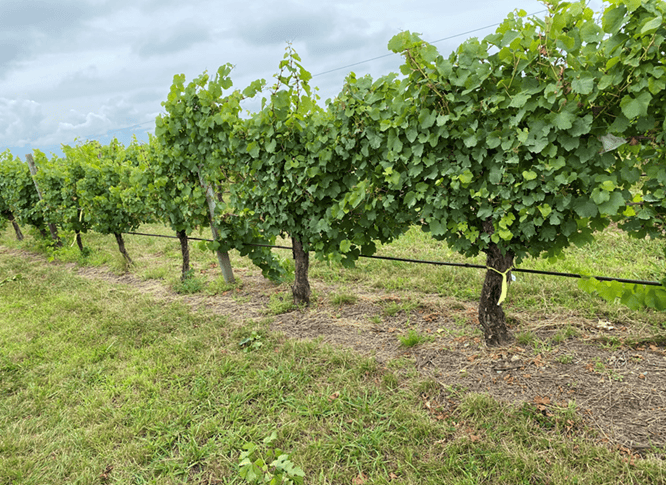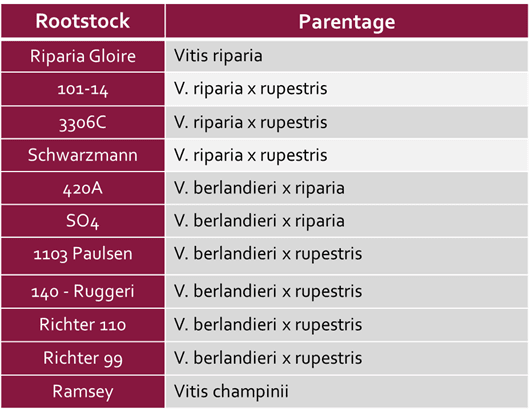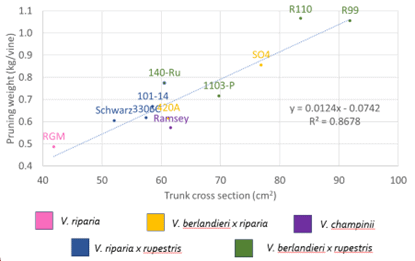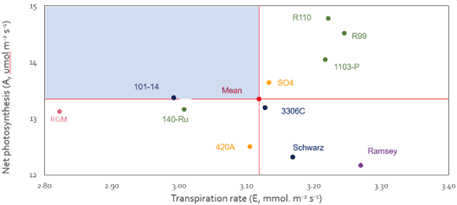Braden Crosby and Yuichi Ando, Bragato Research Institute
Rootstocks are an essential component of grape growing in New Zealand. Rootstocks can influence vine performance, vine longevity, and water and nutrient uptake, and rootstock selection is one of the key decision-making points when selecting new planting material.
Adaptation strategies are required to deal with the changing climate and using more efficient drought-tolerant rootstocks is potentially a sustainable solution. This project aimed to understand the benefits that rootstocks may confer with regards to climate change resilience, sustainability, profitability, and quality so the wine industry could make more informed decisions for their businesses.
There are several parameters needed to make informed decisions on rootstock selection. In this project, Bragato Research Institute (BRI) investigated the Water Use Efficiency (WUE), measured as carbon gain per unit of water loss, of 11 rootstocks and their effect on vine performance, in an established vineyard.
Summary of method
BRI identified several commercial rootstock trials in Marlborough, and selected a vineyard in the Renwick area of the Wairau Valley that contained 11 rootstocks grafted to Chardonnay (Clone 6) and planted in 1994.
Image: Chardonnay vines grafted to Riparia gloire (L) and Richter 99 (R)
Measurements of vine vigour were undertaken, with pruning weights, canopy gaps and trunk cross sectional area monitored. Juice parameters and yield were measured in 2024 to understand the carbohydrate partitioning within the vines. Stem water potential (SWP) was monitored throughout the season and WUE, which was measured as a ratio of photosynthesis (A) over transpiration (E) using a CIRAS-4 Portable Photosynthesis System.
Table 1. Rootstock and parentage
Findings
Vine vigour
Pruning weights, canopy gaps and trunk cross-sectional area varied to a significant level between rootstocks, with parentage playing a role in vine growth and vigour. Vines with Berlandieri x rupestris parentage consistently had higher pruning weights, lower levels of canopy gaps, and larger trunk cross-sectional area. There was no significant difference in pruning weights and canopy gaps between Riparia x rupestris rootstocks, while Riparia gloire had the lowest vigour of all the rootstocks in all metrics that were measured. V. champinii rootstock Ramsey had the lowest pruning weight relative to the trunk area.
Figure 1. Relationship between trunk cross sectional area and pruning weight
Stem water potential
Stem water potential (SWP) was measured as a representation of vine water requirements. SWP readings were tracked during the season with the highest negative pressure occurring in February in both 2023 and 2024. Irrigation was not used on these vines in 2023 and occurred once at the end of February 2024. SWP varied between rootstocks but was not significant in 2024. Given no irrigation was applied to the vines by early February, all rootstocks could access water through non-applied means.
Water Use Efficiency
Water use optimisation was measured as the relationship between photosynthesis and transpiration (Figure 2). Ramsey, Schwarzmann, 420A and Riparia gloire consistently had a photosynthetic rate below the mean. Riparia gloire managed water losses efficiently with low transpiration rates, potentially leading to smaller above-ground structures and smaller canopies. Ramsey and Schwarzmann tended to be inefficient users of water, utilising more water per carbon gain. SO4 tended to be close to the mean in both years, which aligns with observations of vine vigour, yield and brix. Paulsen, R99 and R110 all had a high level of photosynthesis, but to achieve this they used more water, transpiring at a higher rate. These vines had the highest pruning weights and the largest trunk cross-sectional area. This would suggest these vines are using excess photosynthates for building in-season vegetation and permanent structures.
Figure 2. Relationship between Photosynthesis (A) and Transpiration (E) in the 2024 season. The top left-hand box represents optimum vine performance – vines that photosynthesize at a higher-than-average rate, while utilizing less water through transpiration.
Yield and juice parameters
There was no significant difference in yield, pH or YAN. Yield and brix were not associated with the level of photosynthesis, with high photosynthesising vines not producing higher yield or brix, indicating partitioning of carbohydrates is being utilised elsewhere. Brix levels ranged from 21.7 to 22.5, with significant differences, however the brix level also aligns with yield trends.
Malic acid and Titratable acidity varied and appeared to be linked to canopy size, with Riparia gloire having the acidity; while Ruggeri, R99 had the highest malic and along with Paulsen had the highest Titratable Acidity.
Conclusion
In conclusion, the findings of this project and previous studies would suggest that no rootstock performs optimally every season. Vine vigour is strongly related to trunk cross sectional area and parentage. Berlandieri x rupestris crosses have greater trunk cross sectional area and canopy size when compared to Riparia parentage.
Rootstock parentage influenced the construction of permanent structures, which may reflect carbohydrate partitioning. Generally, those that photosynthesised and transpired at a higher rate tended to have larger above-ground permanent structures. Literature would suggest these selections also have larger below-ground structures which might allow them to access more non-applied water sources. These selections might be useful for low vigour scions or under management techniques that lend themselves to reduced vigour such as organic management practices or where water availability is limited. Berlandieri parentage tended to produce larger canopies as vines age in this trial block.
When the ratio of photosynthesis over transpiration is investigated, that is the ratio of water usage for carbon gain, we find there is no significant difference in the instantaneous WUE between rootstocks over both years. The productive WUE of Riparia gloire was highest as it used less water for the same crop and brix level.
Yield, pH and YAN were not significantly different between rootstocks in these years. Brix, TA and malic varied slightly by rootstock. Higher concentrations of malic acid were associated with high vine vigour.
The opportunity to increase genetic diversity in our rootstock selection is large. Having a diversified portfolio of rootstock genetics is a risk mitigation strategy, especially heading into a changing climate scenario.
Further research
This two-year project was part of the information used to help build a body of knowledge before data collection starts on BRI’s Sauvignon Blanc rootstock trial. Based in Marlborough, BRI has 15 rootstocks planted to pair objective scientific observation with industry experience. This project aims to create opportunities for increasing the diversity of future planting stock to mitigate risks associated with climate change, making the New Zealand wine industry more resilient.
About the project:
This two-year project was funded by the New Zealand Winegrowers levy and the MBIE regional research institute fund as part of BRI rootstock project 22-017. Thanks to Yuichi Ando (BRI), Pernod Ricard, Andrew Naylor, Dr Mark Krasnow (Thoughtful Viticulture), Dr Stewart Field (NMIT), Dr Carmo Vasconcelos and Dr Fang Gou (BRI).




















